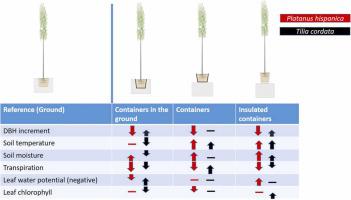Urban Forestry & Urban Greening ( IF 6.0 ) Pub Date : 2022-12-23 , DOI: 10.1016/j.ufug.2022.127822 Mohammad A. Rahman , Christoph Fleckenstein , Vjosa Dervishi , Ferdinand Ludwig , Hans Pretzsch , Thomas Rötzer , Stephan Pauleit

|
The capacity of urban trees in mitigating urban heat is well-known. As space is often limited, one feasible option for increasing the urban green would be containerized plants. Nevertheless, for optimizing the vitality and benefits, detailed knowledge on tree growth reactions in different types of containers is missing. We designed an experiment with two commonly planted but ecologically contrasting urban tree species Tilia cordata and Platanus x hispanica planted into the ground and in containers according to four different planting types, with or without drought stress. Along with the meteorological variables, continuous soil moisture and temperature at 25 cm depth, sap flow, as well as measurements of leaf physiological responses i.e. stomatal conductance, mid-day leaf water potential and chlorophyll content were measured three times on sunny and warm summer days during 2020 and 2021. P. hispanica showed more than double diameter increment at breast height in the ground than in containers; however, the growth trend was relatively better for T. cordata in containers. While comparing different container types and species reactions, it was clear that soil temperature within the plastic containers were significantly higher, whereas insulation is not enough to reduce either the temperature or slowing down the soil drying out. Where both the species showed lower stomatal control over atmospheric demand, P. hispanica showed leaf transpiration energy loss of around 300 W m−2 when planted in the ground and T. cordata trees around 260 W m−2 when planted in non-insulated containers, which are comparable to the energy loss from the street trees. Therefore, a strategy of mixed planting with faster growing species such as P. hispanica that provide stronger cooling at the initial stage in the containers to be complemented and eventually replaced with medium growing species T. cordata for relatively longer time period could be suggested.
中文翻译:

用于城市降温的集装箱树木有多好?
城市树木在缓解城市热量方面的能力是众所周知的。由于空间通常有限,增加城市绿化的一种可行选择是集装箱植物。然而,为了优化活力和效益,缺少关于不同类型容器中树木生长反应的详细知识。我们设计了一个实验,使用两种常见但生态对比鲜明的城市树种Tilia cordata和Platanus x hispanica根据四种不同的种植类型种植在地下和容器中,有或没有干旱胁迫。与气象变量一起,在阳光明媚和温暖的夏季,对 25 厘米深度的连续土壤水分和温度、液流以及叶片生理反应的测量,即气孔导度、正午叶片水势和叶绿素含量进行了三次测量在 2020 年和 2021 年期间。P. hispanica在地面上的胸高直径增量是在容器中的两倍以上;然而,T. cordata的增长趋势相对较好在容器中。在比较不同容器类型和物种反应时,很明显塑料容器内的土壤温度明显更高,而绝缘不足以降低温度或减缓土壤干燥。在这两个物种对大气需求的气孔控制较低的情况下,P. hispanica种植在地面时叶蒸腾能量损失约为 300 W m −2,种植在非隔热容器中时T. cordata树叶蒸腾能量损失约为 260 W m −2,这与行道树的能量损失相当。因此,与P. hispanica等生长较快的物种混合种植的策略可以建议在容器的初始阶段提供更强的冷却,以补充并最终用中等生长的物种T. cordata替换相对较长的时间。











































 京公网安备 11010802027423号
京公网安备 11010802027423号